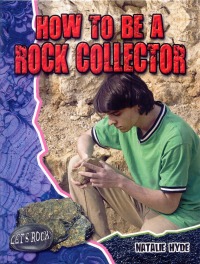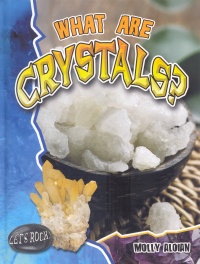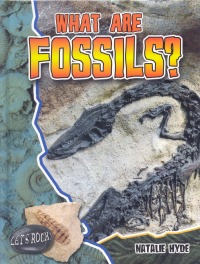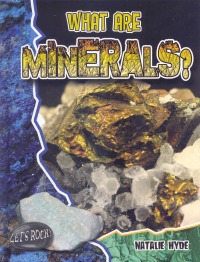| ________________
CM . . .
. Volume XIX Number 7. . . .October 19, 2012 
 |
How to be a Rock Collector. (Let's Rock).
Natalie Hyde.
St. Catharines, ON: Crabtree, 2012.
32 pp., pbk. & hc., $9.95 (pbk.), $20.76 (RLB.).
ISBN 978-0-7787-7217-0 (pbk.), ISBN 978-0-7787-7212-5 (RLB).
Subject Headings:
Rocks-Collection and preservation-Juvenile literature.
Minerals-Collection and preservation-Juvenile literature.
Grades 3-6 / Ages 8-11.
Review by Gail Hamilton.
*** /4
|
| |
|
 |
What are Crystals? (Let's Rock).
Mollie Aloian.
St. Catharines, ON: Crabtree, 2012.
32 pp., pbk. & hc., $9.95 (pbk.), $20.76 (RLB.).
ISBN 978-0-7787-7218-7 (pbk.), ISBN 978-0-7787-7213-2 (RLB).
Subject Headings:
Crystals-Juvenile literature.
Crystallography-Juvenile literature.
Grades 3-6 / Ages 8-11.
Review by Gail Hamilton.
*** /4
|
| |
|
 |
What are Fossils? (Let's Rock).
Natalie Hyde.
St. Catharines, ON: Crabtree, 2012.
32 pp., pbk. & hc., $9.95 (pbk.), $20.76 (RLB.).
ISBN 978-0-7787-7219-4 (pbk.), ISBN 978-0-7787-7214-9 (RLB).
Subject Heading:
Fossils-Juvenile literature.
Grades 3-6 / Ages 8-11.
Review by Gail Hamilton.
*** /4
|
| |
|
 |
What are Minerals? (Let's Rock).
Natalie Hyde.
St. Catharines, ON: Crabtree, 2012.
32 pp., pbk. & hc., $9.95 (pbk.), $20.76 (RLB.).
ISBN 978-0-7787-7220-0 (pbk.), ISBN 978-0-7787-7215-6 (RLB).
Subject Headings:
Minerals-Juvenile literature.
Mineralogy-Juvenile literature.
Grades 3-6 / Ages 8-11.
Review by Gail Hamilton.
*** /4
|
| |
|

excerpt:
Friedrich Mohs was a mineralogist who invented a scale in 1812 to measure the hardness of minerals. All minerals are placed in the scale using a scratch test. The scale rates them from 1 to 10. The softest minerals are 1 and the hardest are 10.
Mohs identified tools or materials that could be used to scratch minerals at each level, such as fingernails for soft materials and sandpaper for harder ones. All minerals can scratch minerals that are the same or lower on the scale, but cannot scratch those that are higher. Talc is a 1 on the Mohs scale. Talc is so soft that it is used to make baby powder. Diamonds are a 10 on the scale and can scratch every other mineral on Earth. (From What Are Minerals?)
These four titles are the latest additions to the "Let's Rock" series which describes the ways in which various rocks are formed, their characteristics, such as composition and colour, and the ways in which humans use rocks to create both decorative and useful objects. Comprised of 13 chapters each, the books explain the scientific concepts in a way that is easy for readers to comprehend. An attractive layout, catchy headings (although some of them are a bit of a stretch, humour-wise), and backgrounds resembling a rocky surface are very appealing. The main body of the text is enhanced by fact boxes as well as diagrams, maps, charts and wonderful colour photographs showing examples of rocks and rock formations from all parts of the world. In addition, there are instructions for a few experiments related to the concepts presented in each of the titles. However, some of the experiments require adult supervision, and a few of them necessitate a trip to the store for some inexpensive items. Words in boldface type appear in a glossary at the back of the book, along with an index and a list of books and websites for further research. A table of contents is also included. There are only a couple of flaws in this series: firstly, some of the terms used are not explained, neither in the body of the text nor in the glossary, and, secondly, there are parts of several photographs whose placement, in the gutter of the book, distorts the photograph.
How to Be a Rock Collector provides helpful tips for novice rockhounds who would like to embark on this enjoyable hobby. Topics range from where to look for rocks (dry river beds, beaches, cliff facings or outcroppings and abandoned quarries) and tools of the trade for obtaining, recording and storing rock specimens, to helpful hints for rock collection displays and related hobbies such as making jewellery from tumbled stones. Other topics include identification and classification of rocks, making sea glass, and organizations for rockhounds. The town of Bancroft, ON, which hosts an annual Rockhound Gemboree, Canada's largest gem and mineral show, is also mentioned. (Unfortunately, the author does not provide any further details such as time of year or duration of the Gemboree.) This title also has instructions for making a pendant and making sea glass (provided that the reader has access to a rock tumbler), as well as an experiment to test rocks for their limestone content.
What Are Crystals? explains how crystals, ranging from salt and ice to rocks, are formed. Crystals can be divided into seven categories, called systems, which are based on different amounts of symmetry. Though there are photographs depicting a rock sample from each of the systems, the terms - cubic, trigonal, tetragonal, hexagonal, orthorhombic, monoclinic and triclinic - are not explained, leaving the reader to try to figure them out by examining the photograph or finding the word in a dictionary. Double-page spreads are devoted to diamonds, quartz, corundum and beryl and provide information about where the largest deposits of each mineral are found as well as its uses, such as diamonds for drill bits, ruby for lasers, and quartz for electronics, watches and sandpaper. Other topics in this title include Moh's scale of hardness for rating minerals, phenomenal crystal caves, and birthstones and their meanings. Experiments and activities range from comparing salt and sugar crystals to making candy crystals to eat.
In What Are Fossils?, readers will learn the many ways in which fossils are formed, the different types of fossils (imprint, index, trace, body and inclusions), and what clues paleontologists look for in order to figure out the age, weight, size, diet and intelligence of the animals whose fossilized remains they have found. They can also tell whether the animal walked upright or on all fours, whether it climbed trees, its speed of movement, what kind of sound it made, and even what disease it might have had. In fact, one rare find, a hadrasaur, still had skin covering parts of its body and tail, leading scientists to determine the size of its muscles and that it had a striped skin pattern. This title also contains information about where to search for fossils, how to start a fossil collection, and rare and unusual fossils, one example being a centipede-like creature with five eyes and a long trunk. Activities include making a fossil out of plaster of Paris, preserving a dead insect in "amber" made from clear nail polish, and going on a fossil hunt.
Minerals are formed from elements present in gases or liquids. What Are Minerals? features the classification of minerals into seven main groups, based on their elements and structure, and their identification by factors such as luster, cleavage, density, hardness, smell and colour. A double-page spread highlights Moh's scale of hardness and provides examples of minerals at each step of the scale. Other topics include how minerals get their names, precious gemstones, where and how geologists find minerals, open pit versus underground mining, and new technologies that are helping to minimize the negative impact of mining on the environment. Finally, the many uses of minerals are discussed, some examples of which are gold in electronics, platinum in fuel cells of cars and computer hard drives, graphite in pencils, steel building frames, and the use of minerals in jewellery, statues, makeup and even in people's diets. Growing stalactites and stalagmites from Epsom salts and making toothpaste out of calcium carbonate, baking soda and food colouring are a few of the activities included in this title.
The "Let's Rock" series his series would be very useful in the elementary classroom.
Recommended.
Gail Hamilton is a former teacher-librarian in Winnipeg, MB.

To comment
on this title or this review, send mail to cm@umanitoba.ca.
Copyright © the Manitoba Library Association. Reproduction for personal
use is permitted only if this copyright notice is maintained. Any
other reproduction is prohibited without permission.
NEXT REVIEW |
TABLE OF CONTENTS FOR THIS ISSUE
- October 19, 2012.
AUTHORS |
TITLES |
MEDIA REVIEWS |
PROFILES |
BACK ISSUES |
SEARCH |
CMARCHIVE |
HOME |



